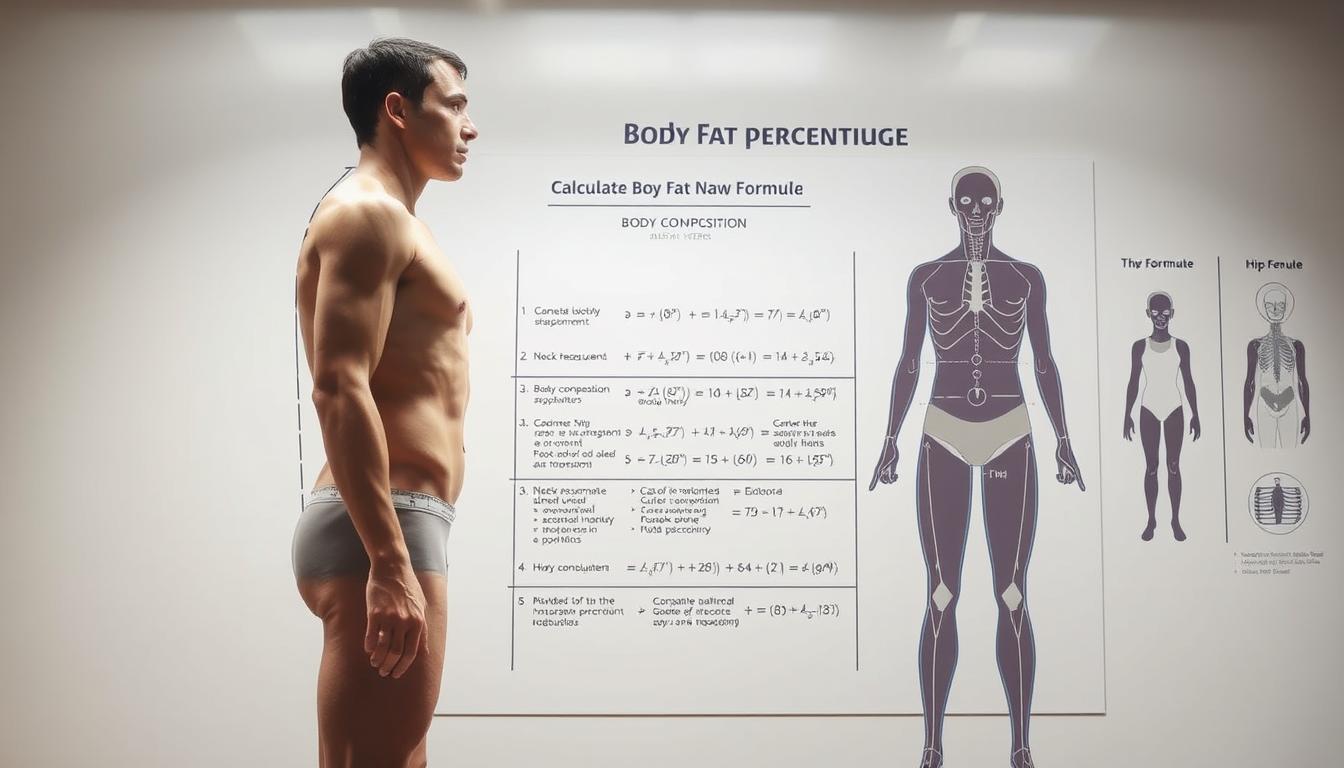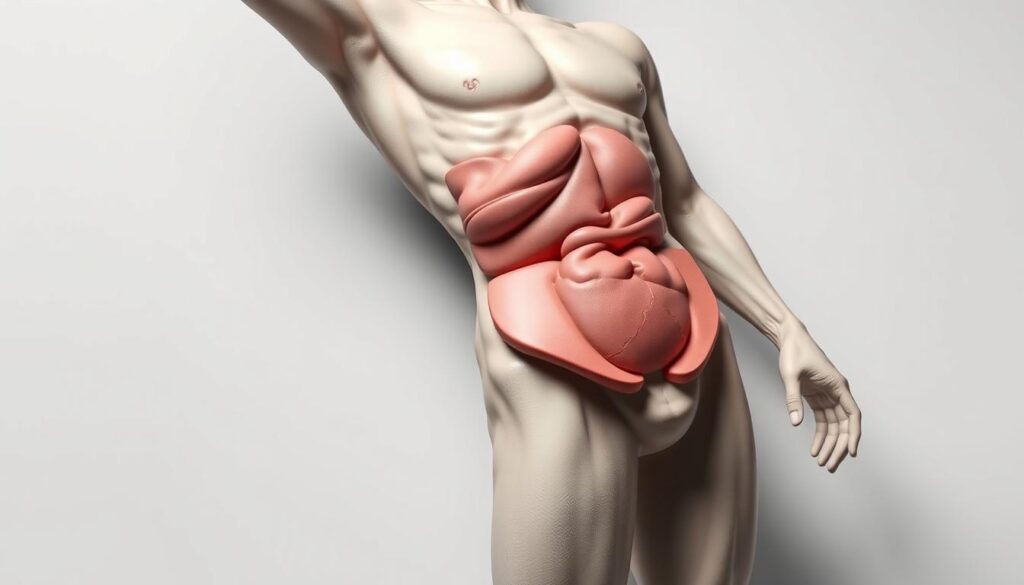“The greatest wealth is health.” – Virgil. This ancient wisdom holds true today, as maintaining a healthy body fat percentage is crucial for overall well-being. Knowing your body fat percentage provides a more accurate picture of your health than weight alone.
We will explore the Navy Method, a reliable technique for measuring body fat without expensive equipment. This method offers a convenient and cost-effective way to assess your health and fitness.
By understanding your fat percentage, you can better track your progress and make informed decisions about your fitness journey.
Key Takeaways
- Learn how to measure body fat using the Navy Method.
- Understand the importance of body fat percentage for assessing health.
- Discover the advantages of the Navy Method over other techniques.
- Track your progress and make informed decisions about your fitness journey.
- Apply the Navy Method for a more accurate assessment of your health.
Understanding the Navy Method
When it comes to measuring body fat, the Navy Method stands out as a simple yet effective approach. This method has been widely adopted for its reliability in estimating body fat percentage. We will delve into the details of this method, exploring its definition, history, and accuracy.
What is the Navy Method?
The Navy Method is a formula used to calculate body fat percentage using circumference measurements. It involves taking precise measurements of various body parts to estimate the percentage of body fat. This method is particularly useful for individuals who regularly exercise and lift weights, as it takes into account muscle mass.
History and Development
The Navy Method was developed by the US Navy as part of a fitness and body composition assessment program. The method has evolved over time to incorporate more accurate measurements and formulas. It is designed to provide a reliable estimate of body fat percentage using simple, non-invasive techniques.
Accuracy and Reliability
The Navy Method is known for its accuracy, typically getting within 3-4% of the true body fat percentage for most individuals. It is more accurate than many bioelectrical impedance scales, especially for tracking changes over time. However, it may have limitations for individuals with unusual body proportions or extremely muscular physiques. Consistency in measurement technique is crucial for reliable results.
- The Navy Method is more accurate than many bioelectrical impedance scales.
- It accounts for muscle mass, making it suitable for athletes.
- Consistency in measurement is key to reliable results.
Required Measurements for the Navy Method
The Navy body fat calculation method requires precise measurements to produce accurate results. To begin, you’ll need to gather a few simple tools and understand how to take the necessary measurements.
Equipment You’ll Need
To take the required measurements, you’ll need a few basic tools: a measuring tape, a scale, and a calculator. A measuring tape is crucial for taking circumference measurements, while a scale will be used to measure your weight.
Height and Weight Measurements
First, measure your height and weight. Stand on a scale to record your weight, and use a stadiometer or a ruler against a wall to measure your height accurately. Ensure you’re standing upright and looking straight ahead when taking your height measurement.
Neck Circumference Measurement
To measure your neck circumference, wrap a measuring tape around the narrowest point of your neck, just below the larynx. Keep the tape level and parallel to the floor. This measurement is crucial for both men and women.
Waist Circumference Measurement
For the waist circumference, measure around the narrowest point of your natural waistline, keeping the tape level and parallel to the floor. This measurement is essential for calculating body fat percentage.
Hip Circumference Measurement (for Women)
For women, an additional measurement is required: hip circumference. Measure around the widest point of the buttocks, keeping the feet together and ensuring the gluteal muscles are relaxed. This measurement helps account for the tendency of women to store more fat in the hip and thigh areas.
As noted by health experts, “The distribution of body fat, particularly around the waist and hips, is a significant indicator of health risks.”
“Body fat distribution is a critical factor in determining health outcomes, with central obesity being a significant risk factor for various chronic diseases.”
Understanding these measurements and how they contribute to your overall body fat percentage is vital.
| Measurement | Men | Women |
|---|---|---|
| Height | Required | Required |
| Weight | Required | Required |
| Neck Circumference | Required | Required |
| Waist Circumference | Required | Required |
| Hip Circumference | Not Required | Required |
How to Calculate Body Fat Using Navy Method
The Navy method offers a straightforward way to estimate body fat using simple measurements. This method is widely used due to its relative simplicity and the fact that it doesn’t require specialized equipment beyond a tape measure and a calculator.
The Formula for Men
For men, the Navy method uses the following formula to calculate body fat percentage: 495 / (1.0324 – 0.19077 * log10(waist – neck) + 0.15456 * log10(height)) – 450. Here, waist and neck circumferences are in inches, and height is in inches. This formula is derived from the relationship between body density and body fat.
To illustrate, let’s consider a male subject with a waist circumference of 35 inches, a neck circumference of 16 inches, and a height of 70 inches. Plugging these values into the formula gives us a body fat percentage of approximately 18.4%. This calculation provides a clear estimate of body fat.
The Formula for Women
For women, the formula is slightly different: 495 / (1.29579 – 0.35004 * log10(waist + hip – neck) + 0.22100 * log10(height)) – 450. Here, waist, hip, and neck circumferences are in inches, and height is in inches. This formula takes into account the different body composition patterns in women.
For example, a female subject with a waist circumference of 30 inches, a hip circumference of 40 inches, a neck circumference of 14 inches, and a height of 65 inches would have a calculated body fat percentage of about 22.1%.
Using Online Calculators
While the formulas can be computed manually, many online calculators are available that simplify the process. These tools require you to input your measurements and then calculate your body fat percentage automatically. Using an online calculator can save time and reduce the chance of arithmetic errors.
Example Calculations
Let’s consider a few examples to demonstrate how the Navy method works. For a male with a waist of 38 inches, neck of 17 inches, and height of 72 inches, the calculated body fat percentage might be around 21.5%. For a female with a waist of 32 inches, hip of 42 inches, neck of 15 inches, and height of 68 inches, the body fat percentage could be approximately 25.3%. These examples show how different measurements yield different body fat estimates.
As
“Accurate measurements are crucial for obtaining a reliable body fat percentage using the Navy method.”
Small errors in measuring circumference can lead to significant differences in the calculated body fat percentage, emphasizing the importance of precise measurements.
Interpreting Your Body Fat Percentage Results
Interpreting your body fat percentage results is a critical step in understanding your health and fitness journey. Once you have calculated your body fat percentage using the Navy method, you can begin to understand what your results mean and how they relate to your overall health and fitness goals.
Healthy Body Fat Percentage Ranges
Understanding the healthy ranges for body fat percentage is essential for interpreting your results. For adults, the American Council on Exercise (ACE) defines the following categories: for men, 2-4% is considered essential fat, 6-13% is athletic, 14-17% is fitness, 18-25% is average, and 26% or higher is considered obese. For women, 10-12% is essential fat, 16-23% is athletic, 24-31% is fitness, 32-40% is average, and 41% or higher is obese. Maintaining a body fat percentage within the healthy range can significantly reduce the risk of chronic diseases, such as diabetes and heart disease.
As noted by the National Academy of Sports Medicine, “Body fat percentage is a more accurate indicator of health risks than weight or BMI alone.” This highlights the importance of considering body composition in your health assessments.
What Your Results Mean
Your body fat percentage result provides insight into your body composition, indicating the proportion of fat mass to lean mass. A lower body fat percentage typically indicates a higher level of fitness, but it’s also important to consider other factors such as muscle mass and overall health. For instance, an athlete with a low body fat percentage may still have health risks if they have a high level of visceral fat around their organs.
To get a more comprehensive picture, consider tracking additional measurements like waist circumference or waist-to-shoulder ratio. As tracking body fat percentage changes over time is more informative than a single measurement, regular assessments can help you understand the effectiveness of your fitness and nutrition strategies.
Tracking Changes Over Time
Tracking changes in your body fat percentage over time is crucial for understanding your progress. It’s recommended to take measurements every 2-4 weeks to monitor changes effectively. To ensure accurate comparisons, maintain consistent measurement conditions. When tracking progress, consider that a change of 0.5-1% per month is a realistic and healthy rate. Be cautious of too-rapid changes, as they may indicate unhealthy practices.
To effectively track your progress, consider using a spreadsheet or a fitness app to visualize your changes over time. This can help you stay motivated and make informed decisions about your fitness and nutrition plan. By monitoring your body fat percentage and other relevant metrics, you can adjust your strategies to achieve your health and fitness goals.
Comparing the Navy Method to Other Body Fat Measurement Techniques
Understanding the different methods for measuring body fat is crucial for choosing the most appropriate technique for your needs. We compare the Navy Method to other common techniques, discussing their relative advantages and limitations.
The Navy Method is often compared to more advanced techniques like DEXA scans and underwater weighing, considered gold standards in body fat measurement. While these methods offer high accuracy, they are typically more expensive and less accessible than the Navy Method. In contrast, the Navy Method provides a practical and cost-effective way toestimate body fat percentageat home.
Other methods, such asbioelectrical impedance analysis (BIA) scales, are also popular for their convenience. However, BIA scales can be less accurate for individuals who exercise regularly, as they may not account for changes in muscle mass. The Navy Method, on the other hand, tends to provide more consistent results for athletes and active individuals by directly measuringwaist circumferenceand other body dimensions.
Skinfold caliper measurements offer another alternative, but their accuracy depends heavily on the skill of the person taking the measurements. BMI, while useful for general health assessments, does not directly measurebody fat percentage, making it less informative for fitness tracking.
Whentracking body fatover time, consistency in measurement method is key. For most people, the Navy Method strikes a good balance between accuracy and convenience, making it an excellent choice for regular monitoring without the need for expensive equipment.


